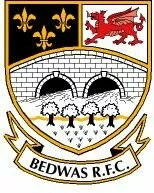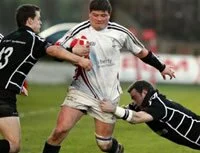|
Bedwas RFC
The history of the club has revolved entirely around the close-knit community of the village of Bedwas, situated just South East of the castle town of Caerphilly at the mouth of the Rhymney Valley, a farming area that became a thriving mining community, now a light industrial center that still retains much of its original rural charm. Research has established that Bedwas had a side and played a match in 1885, prior to official recognition in 1889 and in the 1896/97 season ran a second fifteen, headquarters being the Royal Oak Inn.
|
|
|
1903 saw the formation of the Junior Monmouthshire League, comprised of a dozen clubs, including Bedwas, which was also a founder club of the Rhymney Valley League formed in 1906 from the valley's strongest clubs, and then fielded an Old Boys Team. 1910 was an important year, membership of the W.R.U. granted, followed by the Welsh Rugby Cup being introduced in 1913, the clubs divided into four districts, Bedwas in the Eastern District along with Newport, Cardiff and Machen.
|
The club gained a reputation for attractive running rugby until the advent of World War One ended rugby in the village, after which, as in other clubs, a period of rebuilding to pre-war standards was necessary. After a period based at the Church Inn, they re-established at the Bridge End Inn in 1920/21 with some distinguished officers, among them Sir Samuel Instone, whose company bought the Bedwas Colliery (operational in 1914) in 1921 and, on winning the prestigious Kings Cup Air Race brought the cup to Bedwas for display in a village shop.
The General Strike of 1926 brought unemployment and hardship to the area with disastrous consequences for the club, many young men emigrating or seeking employment elsewhere but the club with its dedicated following, struggled on, regaining its formidable reputation and in the "glorious thirties" established a five year ground record, 1929 to 1933 with records such as 30/31 played 34, lost 1; 31/32 played 29, lost3; 32/33 played 33, lost 2 and that season only 41 points scored against them and had in Trevor Evans, a centre of brilliance who resisted many offers to turn first class, remaining loyal and captained the club for a decade.
Apart from the big clubs, facilities were usually a room in a pub, zinc baths and bread, cheese and pickles. Compare that with today's facilities and wonder at the dedication of that era! Once again the flames of war disrupted the continuity of the club, but prior to the war ending in 1945, meetings were in hand to re-establish, the White Hart and Church House Inns being used as headquarters until, in 1947 the club obtained Bridge field as it's ground and an ex Ministry of Works long hut as its first clubhouse. All the subsequent hard work of construction, improvements, showers, dressing rooms necessary were undertaken by club members and officially opened by then Welsh Captain, John Gwilliam and after sustained negotiation the first lease on the ground was obtained.
The 1950s saw the club further its already fine reputation, both playing and administration, a reputation still maintained. In 1960/61 the Youth side was formed. Much of the club's success may be attributed to such men as E.B.Williams, a legendary figure of influence over 50 years, Harold Cooper J.P., Chairman for over 33 years. And Alan Reed, Secretary for 18 years and who can forget Cyril Gregory, a club stalwart who was also Chairman of the South Mon Union, Welsh Youth National Representative and Mon R.U. Chairman.
|
|
The club progressed through the sixties with varying success as a thriving concern, 1965 saw the Third Team revived and an impressive 1966/67 season saw the First XV losing 5 of 36 and the Second XV losing 4 of 32 matches. The seventies and eighties brought further success, Mon league champions, Mon Sevens Champions, Aberaeron Sevens, Harringay London Sevens and many other cups. Bedwas then achieved what no other "second class club" had done and is likely to do, in reaching the quarter finals of the then Schweppes Cup, now Welsh Cup, for three successive years, 1977 to 1980 losing to international packed sides, Geoff Wheel's Swansea twice and Alan Martin's Aberavon. Highly successful tours abroad were made, to Czechoslovakia, Canada, Holland to name but a few and the club has hosted matches against teams from Australia, New Zealand, Canada and Europe maintaining its winning ways.
The club celebrated its official Centenary in 1989, and the fact that rugby has been played at Bedwas for a period of 100 years is testament to the dedication of all the administrators and players that made the celebration possible.
Bedwas has had several Internationals with Eddie Watkins gaining 8 caps in 1935, Terry Cook gaining 2 in 1949, Leighton Jenkins 8 in 1954, Jeff Whitefoot 19 from 1982 including the World Cup in New Zealand and Ben Evans, a former Youth player, 5 caps to date from 1999 and not forgetting Roy Duggan, selected from the club for Gwent v All Blacks in 1972, together with an impressive list of Schoolboy, Youth, Crawshay, Under 21 and county caps.
The 90s saw the advancement of the club to National League Champions the stepping stone into the Heineken League and progress through the newly structured W.R.U. Divisions, which saw the era of conversion to professional rugby, from Division 5 to Division 2 for the 2000/1 season under the astute Chairmanship of Peter Rawlins.
A far cry from its early history the club now offers fine playing fields, a large parking area, floodlights, a Clubhouse with spacious dressing rooms, physio and weights rooms, dining room and three bars and intends to continue its progressive and business-like approach to sound administration and playing strength to meet the ever increasing demands of participating in the top echelons of Welsh Rugby.
Yes, rugby at the village has travelled a long, difficult but steadfast path since that first match in 1885.
Click here to visit Bedwas RFC home page
|
|


